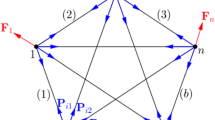Abstract
Systems of rigid and flexible bodies undergoing large rigid body motions but small elastic deformations are investigated. In order to get the correct equations of motion one has to consider geometric nonlinearities even in the elastic coordinates. Different possibilities of independently choosing these coordinates are presented. The flexible bodies are discretized using a Ritz-Galerkin approximation. This discretization leads to ordinary differential equations for the description of the clastic vibrations of the flexible bodies as well as for the description of the rigid body motions.
The modelling of deformable bodies is one aspect of our investigations. Another aim of our research is the consideration of clastic bodies in existing multibody programs, in particular in the program AUTOLEV. This is a symbol manipulating program for the formulation of the equations of motion running on PCs. Two examples are considered showing that it is possible to treat clastic bodies in this and in similar programs with the concept of modelling presented above.
Similar content being viewed by others
References
Clemens, H., Stabilitätsprobleme clastischer Stäbe und Platten mit nichtlinearer Verformungsgeometrie. Dissertation, Universität Karlsruhe, 1983.
Hagedorn, P.,Nichtlineare Schwingungen. Wiesbaden, Akademische Verlagsgesellschaft, 1978.
Hagedorn, P.,Technische Schwingungslehre, Band 2. Berlin, Springer-Verlag, 1989.
Hodges, D. H., Proper Definition of Curvature in Nonlinear Beam Kinematics.AIAA Journal 22 (12), 1984. 1825–1827.
Ider, S. K. and Amirouche, F. M. L., Influence of Geometric Nonlinearities in the Dynamics of Flexible Treelike Structures,Journal of Guidance, Control, and Dynamics 12 (6), 1989, 830–837.
Johanni, J., Automatisches Aufstellen der Bewegungsgleichungen von baumstrukturierten Mehrkörpersystemen mit elastischen Körpern. Diplomarbeit Technische Universität München, 1984.
Kane, T. R., Likins, P. W., and Levinson, D. A.,Spacecraft Dynamics, New York, McGraw-Hill Book Company, 1983.
Kane, T. R. and Levinson, D. A.,Dynamics: Theory and Applications, New York, McGraw-Hill Book Company, 1985.
Kane, T. R., Ryan, R. R. and Banerjee, A. K., Dynamics of a Beam Attached to a Moving Base.Journal of Guidance, Control, and Dynamics 10, 1987, 139–151.
Modi, V. J., Attitude Dynamics of Satellites with Flexible Appendage—A Brief Review,AIAA Journal 11, 1974.
Nayfeh, A. H. and Mook, D. T.,Nonlinear Oscillations. New York, Wiley, 1979.
Putter, S. and Manor, H., Natural Frequencies of Radial Rotating Beams,Journal of Sound and Vibration 56 (2), 1978, 175–185.
Schaechter, D. B., Levinson, D. A., and Kane, T. R.,AUTOLEV User's Manual. On Line Dynamics, Inc., Sunnyvale 1988.
Truckenbrodt, A., Bewegungsverhalten und Regelung hybrider Mehrkörpersysteme mit Anwendung auf Industrieroboter, Dissertation Technische Universität München, 1980.
Vigneron, F. R., Comment on Mathematical Modelling of Spinning Elastic Bodies for Modal Analysis,AIAA Journal 13 (1), 1975, 126–127.
Author information
Authors and Affiliations
Rights and permissions
About this article
Cite this article
Botz, M., Hagedorn, P. Multiple body systems with flexible members. Nonlinear Dyn 1, 433–447 (1990). https://doi.org/10.1007/BF01856947
Issue Date:
DOI: https://doi.org/10.1007/BF01856947




